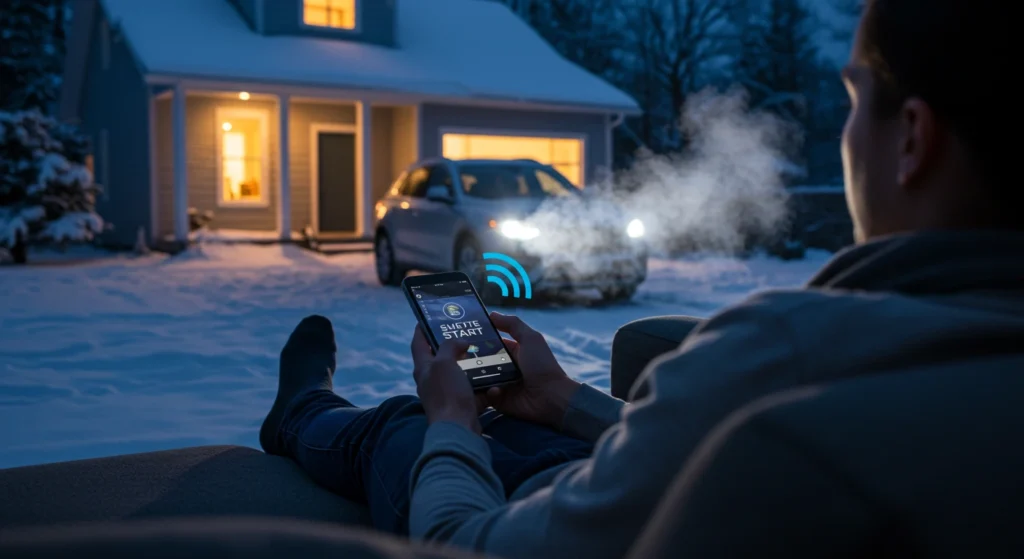Plug and Play Remote Start – Easy DIY Installation Kits Available

Introduction
Have you ever shivered in the freezing cold while waiting for your car to warm up, or melted in summer heat while your vehicle’s AC struggles to kick in? What if you could start your vehicle with the press of a button from the comfort of your home or office? In 2025, plug and play remote start systems have revolutionized the automotive convenience market, making what was once a luxury feature accessible to virtually any vehicle owner. Unlike traditional remote starters that required professional installation and complex wiring, today’s plug and play remote start kits offer a true DIY solution that can save you hundreds in installation costs. But are these systems really as simple to install as manufacturers claim, and do they work with all vehicles? Let’s dive into everything you need to know about this game-changing automotive technology.
Table of Contents
Key Specs & Features
Modern plug and play remote start systems come packed with features that were once only available in high-end vehicles. Here’s what you can expect from today’s leading kits:
- Range: 1,000-3,000 feet (standard) to 1-3 miles (premium models)
- Installation Time: 15-45 minutes for most vehicles
- Compatibility: 90% of vehicles manufactured after 2006
- Smartphone Integration: Most mid-range and premium kits offer app control
- Temperature Sensors: Auto-start based on preset temperature thresholds
- Security Features: Vehicle immobilization and theft detection
- Two-Way Communication: Confirmation when your vehicle starts
- Additional Controls: Trunk release, panic button, cabin pre-heating/cooling
What sets modern kits apart is their true plug-and-play nature—connecting directly to your vehicle’s OBD-II port or factory connectors without splicing a single wire. This represents a significant advancement over traditional systems that required intrusive installation procedures.
Performance & Driving Experience
The impact of a plug and play remote start system extends beyond mere convenience. Modern systems integrate seamlessly with your vehicle’s factory electronics, ensuring smooth operation without affecting performance or voiding warranties. The starter engages your engine just as if you were turning the key yourself, allowing proper warm-up cycles that can extend engine life in colder climates.
Users report significant improvements in winter driving experiences, with pre-warmed engines showing better initial performance and reduced wear. “My morning commute transformed completely,” says Mike Larson, a Minnesota resident who installed a plug and play system last winter. “No more scraping ice while freezing—I just press a button from my kitchen, and by the time I get to my car, it’s warm and ready to go.”
The performance distinction between budget ($80-150) and premium ($200-350) systems typically comes down to range, additional features, and app integration quality rather than core functionality.
Interior & Technology
Today’s plug and play remote start systems offer impressive technology integration that goes well beyond simply starting your vehicle:
- Smartphone Apps: Most systems now pair with dedicated apps that provide virtual key fobs, vehicle status updates, and geofencing capabilities
- Digital Assistant Integration: Premium models support voice commands through Google Assistant, Amazon Alexa, and Apple Siri
- Climate Control: Advanced systems can activate heated seats, defrosters, and set climate temperatures automatically
- Customizable Settings: Program runtime duration, auto-shutdown parameters, and safety features
- Notification Systems: Receive alerts about vehicle status, temperature, and security events
The user interfaces have improved dramatically in recent years, with most manufacturers offering intuitive apps that provide at-a-glance information about your vehicle’s status. However, there’s still a noticeable gap between mid-range and premium options, particularly in terms of reliability and additional features.
Pros:
- Clean dashboard integration without additional fobs (app-based systems)
- Real-time vehicle monitoring and status updates
- Customizable start schedules and climate settings
Cons:
- Budget models may lack smartphone integration
- Some apps require subscription fees after the first year
- Occasional connectivity issues in areas with poor cellular coverage
Fuel Economy & Maintenance Costs
A common concern with remote starters is their impact on fuel consumption and vehicle wear. Modern plug and play remote start systems are designed to minimize these concerns through intelligent features:
- Smart Idle Control: Optimizes engine warm-up time to reduce unnecessary idling
- Automatic Shutdown: Turns off the vehicle if left running beyond a preset time (typically 10-15 minutes)
- Temperature-Based Activation: Some systems only activate when outside temperatures fall below or rise above certain thresholds
According to data collected by RemoteLink, a leading remote start manufacturer, the average additional fuel consumption amounts to approximately 0.025-0.05 gallons per remote start session in moderate weather conditions. For a typical user who remote starts their vehicle 5 times weekly, this translates to roughly $25-50 in additional fuel costs annually—a small price for the added comfort and convenience.
Maintenance implications are generally minimal, with no significant impact on battery life or starter wear reported in vehicles with properly installed systems. In fact, in extremely cold climates, engine pre-warming can actually reduce wear and extend engine life by ensuring proper oil circulation before driving.
Safety Features & Ratings
Safety remains paramount in the design of modern plug and play remote start systems:
- Anti-Theft Protection: Vehicles remain locked during remote start operation
- Automatic Shutdown: Engine turns off if brake pedal is pressed without key in ignition
- Neutral Safety Switch Compatibility: Prevents starting in gear (manual transmissions)
- Hood Pin Sensors: Disable remote start when hood is open (preventing injury during maintenance)
- Carbon Monoxide Protection: Runtime limiters prevent excessive idling
While remote starters themselves aren’t safety-rated by organizations like the IIHS or NHTSA, the top manufacturers adhere to strict quality and safety standards. Leading brands like Compustar, Viper, and Crimestopper have earned industry recognition for their reliability and safety features.
An often overlooked safety benefit is improved visibility during winter months—no more driving with partially cleared windows because you were in a rush to escape the cold.
Who Should Buy This System?
Plug and play remote start systems are particularly valuable for:
Cold Climate Dwellers: If you live in regions where temperatures regularly drop below freezing, the ability to warm your vehicle before entering is not just a luxury but a quality-of-life improvement. Pre-warming also helps clear ice and snow from windows, improving driving safety.
Hot Weather Commuters: Those in areas with extreme summer temperatures can cool their vehicle before entry, making leather seats bearable and reducing the time needed to achieve a comfortable cabin temperature.
Parents With Young Children: Anyone who’s struggled to buckle children into car seats in extreme temperatures will immediately appreciate the value of a climate-controlled vehicle.
Busy Professionals: For those on tight schedules, the time saved not waiting for defrosting or temperature adjustment can add up significantly over time.
Tech Enthusiasts: If you enjoy smart home integration and connected devices, modern remote start systems offer another extension of your digital ecosystem.

Common Issues or Complaints
While plug and play remote start technology has improved dramatically, potential buyers should be aware of common limitations:
- Compatibility Challenges: Despite manufacturer claims, about 10% of vehicles may have compatibility issues, particularly those with advanced security systems or push-button ignition
- Range Limitations: Physical obstructions and building materials can significantly reduce the effective range
- Battery Drain: Some users report increased battery drain, particularly with systems that maintain constant communication with smartphone apps
- Warranty Concerns: Some vehicle manufacturers may consider remote starters as grounds for voiding certain warranty aspects if problems can be traced to the aftermarket device
According to consumer reports, the most reliable systems come from established brands like Compustar, Viper, and Fortin, with complaint rates below 5%. Budget systems under $100 show significantly higher failure rates, with complaints centered around installation difficulties and range issues.
Comparison to Competitors
When comparing plug and play remote start options to traditional hardwired systems and factory-installed options:
| Feature | Plug and Play Systems | Traditional Hardwired | Factory Installed |
|---|---|---|---|
| Cost | $80-350 | $250-500 + Installation ($200-400) | $300-1,200 (dealer option) |
| Installation Difficulty | Low (DIY friendly) | High (Professional recommended) | N/A (Pre-installed) |
| Vehicle Integration | Good | Excellent | Perfect |
| Feature Set | Good to Excellent | Excellent | Variable by manufacturer |
| Warranty Impact | Minimal (removable) | Potential concerns | None |
| Resale Impact | Neutral/Positive | Neutral/Positive | Positive |
The clear advantage of plug and play systems is their combination of affordability and DIY installation, though they may lack some advanced features of professional installations.
Resale Value & Warranty
Installing a plug and play remote start system typically adds $100-200 to a vehicle’s resale value, according to Kelley Blue Book data. The removable nature of these systems is particularly advantageous—you can take it with you to your next vehicle if desired.
Warranty coverage varies by manufacturer:
- Most offer 1-3 year limited warranties on parts
- Premium brands may offer lifetime warranties on the main module
- Installation errors are typically not covered (advantage of factory systems)
As for vehicle warranties, the plug-and-play nature of modern systems significantly reduces warranty concerns compared to hardwired alternatives. Since they connect to factory diagnostic ports or connectors without wire splicing, they’re considered less invasive by most manufacturers.
Conclusion
For the vast majority of vehicle owners, a plug and play remote start system represents one of the most accessible and practical automotive upgrades available today. With installation times under an hour for most vehicles, reasonable costs, and significant comfort benefits, these systems offer compelling value. Whether you’re battling extreme temperatures, seeking extra convenience, or simply enhancing your vehicle’s feature set, today’s plug and play remote start kits deliver impressive functionality without the complexity or expense of professional installation. As technology continues to advance, we can expect even more seamless integration and additional features in coming years—making this an excellent time to consider adding this feature to your vehicle.
Have you installed a remote start system in your vehicle? Share your experience in the comments below, or reach out with questions about compatibility with your specific make and model!
FAQs
Can I install a plug and play remote start system in a manual transmission vehicle? While possible, manual transmission vehicles require additional safety components to prevent starting while in gear. Look specifically for systems designed for manual transmissions that include clutch bypass modules.
Will installing a plug and play remote starter void my vehicle’s warranty? Generally no—the Magnuson-Moss Warranty Act protects consumers, and manufacturers must prove the aftermarket device caused a specific problem. Plug and play systems that don’t modify factory wiring pose minimal risk to warranties.
How far away can I be to start my vehicle with these systems? Standard systems typically work from 1,000-3,000 feet away. Premium models with cellular connectivity can work from virtually anywhere with internet access.
Do these systems work with hybrid or electric vehicles? Most modern plug and play systems offer compatibility with hybrid vehicles, though functionality may be limited compared to conventional engines. Full electric vehicles typically don’t benefit from remote starters but may offer climate pre-conditioning through factory apps.
Can I install a plug and play remote start myself if I have no mechanical experience? Yes—that’s the primary advantage of these systems. Most include step-by-step instructions and require only basic tools. Installation typically involves locating your vehicle’s OBD port or key cylinder connectors and securely attaching the module.






